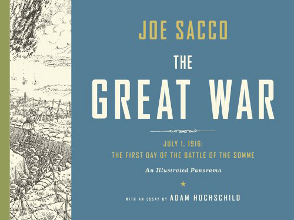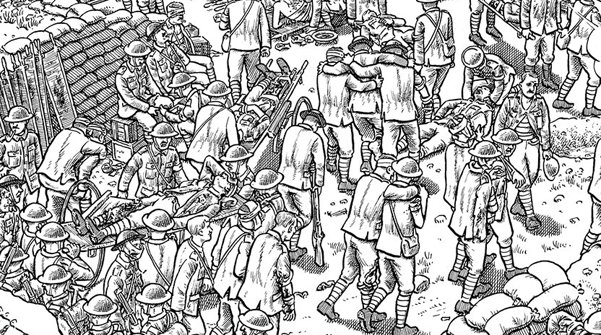 Home > CR Reviews
Home > CR Reviews The Great War: July 1, 1916: The First Day of the Battle of the Somme
posted October 8, 2013
The Great War: July 1, 1916: The First Day of the Battle of the Somme
posted October 8, 2013

 Creator:
Creator: Joe Sacco
Publishing Information: WW Norton, hardcover/slipcase, 54 pages, November 2013, $35
Ordering Number: 0393088804 (ISBN10); 9780393088809 (ISBN13)

I had a blast reading this Joe Sacco-created tapestry style treatment of a key day in World War I history, perhaps more than I should have given the grim history on display. The Battle Of The Somme was one of the grander "Big Push" efforts in the War To End All Wars, one that spoke to the limits of military planning, the accelerated ability of soldiers to kill if given an easy-to-find target and the entrenched difficulties in changing course on a battlefield once orders are given. Whether you consider World War I the last of the old wars, the first of the wars to come, or paired with the US Civil War the latter half of a strange transitional period in the art of systematic murder for political gain, there's no denying that day's very specific tragedies. Tens of thousands of young men were murdered here, or died accidentally by being in close proximity to the murdering, history altered in that specifically haunting way where we have no way of ever knowing the real cost.
This is an accordion-style, single illustration that Sacco decided to give a narrative component: day becomes night becomes day as we push our way left to right from a vantage point near the front of Allied lines. There's something specifically haunting about the effects of a war rolling over a single landscape because of the irrevocable nature of what occurs; this is a stretch of countryside that is being pulled into hell and spit out again. Wars are marked on land the way that natural disasters are, and seeing, for instance, the overnight bombing swell to inhuman levels is like watching a magnificent rainstorm. Sacco's art provides significant clarity to his story moments. Once I realized I was reading a narrative I tried to note the story points as I went; according to a key in a later section of the book, I only missed two, and I'm not a very attentive reader in terms of visual cues. The soldiers Sacco draws are for the most part hard to tell apart as it is easy to note differences in vehicles and structures. My main memory of
The Great War when I put the book down was the number of young men depicted. There are so many people here, working jobs that are mostly banal, many then dying with similar, empty consequence.
I don't know the audience for this book. I know that after the Great War there was a great deal of writing about it. I was told as an undergraduate that modern history in Britain was fashioned from a desire to process The Great War as much as US history coalesced from a series of strategies of trying to make sense of the Civil War -- another way to link those two conflicts. I would imagine that the First World War maintains a hold on the imagination the way that all events that punch a hole in our collective experience stick around: imagery, ideas, concepts that continue to resonate even as the thing itself lies far enough in the past to allow multiple attempts at ascribing meaning. The thing I can't get over with Sacco's treatment of that horrible 48 hours is that landscape drawings of conflict is what boys drew all the time when I was one.
The Great War has an energy that any art-oriented kid would recognize; one can imagine its creation or at least consumption in close proximity to a peanut butter and jelly sandwich and a glass of milk. Only here that child's way of making sense is put into service of an overriding moral point: the cost of human life in the face of wanting things to turn out just so.



